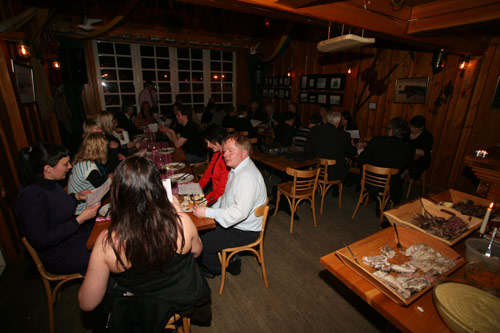North Sailing celebrates Þorri
On Friday 26th January the North Sailing team gathered in Gamli Baukur restaurant and celebrated Thorrablot (Icel. Þorrablót), an old Icelandic food feast tradition.
It´s always a great pleasure when we get the chance to meet each other during the winter time and mingle and get in the right spirit for next season.
Following is a further description of Thorri and Thorrablot found on the web.
Þorri is one of the old Icelandic months. It always begins on a Friday, between the 19th and the 25th of January, and ends on a Saturday between the 18th and 24th of February. The first day of Þorri is called Bóndadagur or ´Husband´s Day/Farmer´s Day´, and is dedicated to men (formerly only farmers). In my family (and many others) , the women bring the men breakfast in bed on this day – just as the men will do on Konudagur – Woman´s Day (if they know what´s good for them). Many women will give their husbands flowers as well. This is a fairly new custom, introduced by flower shops in order to sell more roses. (Now they are trying import Valentine´s Day for the same reason).
The tradition of a Þorri feast is an ancient one. It has its roots in old midwinter feasts, Þorrablót, which the advent of Christianity could not quite abolish, although the way in which it is celebrated has changed. This month falls on the coldest time of the winter, and therefore it is no surprise that Þorri has become a personification of King Winter. He is usually portrayed as an old man, tall and grizzled, who is as cruel to those who disrespect him as he is gentle to those who show him respect. Some have suggested that the month is named after the legendary king who united Norway into one country. Others think it is derived from the name of the thunder-god Þór (Thor), and that this was his feast during the pre-Christian era in Iceland. The story of this old feast and the changes it has gone through is both long and fascinating, and will not be told here.
Whatever the origin of the feast of Þorri, it is today a standard part of the Icelandic social calendar, and has even been exported to many countries which have ex-pat Icelandic populations (often to the utter dismay of foreign friends and spouses). The eating habits of the Icelandic nation have changed a lot in the last hundred years or so, and it is only during Þorri that many people will eat the old-fashioned food. As this feast takes place in the middle of winter, it is no surprise that most of the food served at the feasts is preserved in some way: by pickling in whey, salting, smoking, drying or putrefying.
A typical Þorrablót takes place at any time during Þorri. The season for it now extends into the following month, Góa, but the feast is then usually dubbed Góugleði. It is advisable to hold it on a Friday or Saturday night, to give the participants time to recover from the effects of overeating and heavy drinking that goes with a good Þorrablót. The form the feast takes is similar everywhere, the indispensable ingredients being merrymaking and lots of food. Additional ingredients are staged entertainment (often a cabaret or revue), dancing and lots of alcohol.
For further reading on Þorrablót and the menu which is served, go to: http://www.isholf.is/gullis/jo/feasts_and_celebrations.htm#thorri
ÞH












